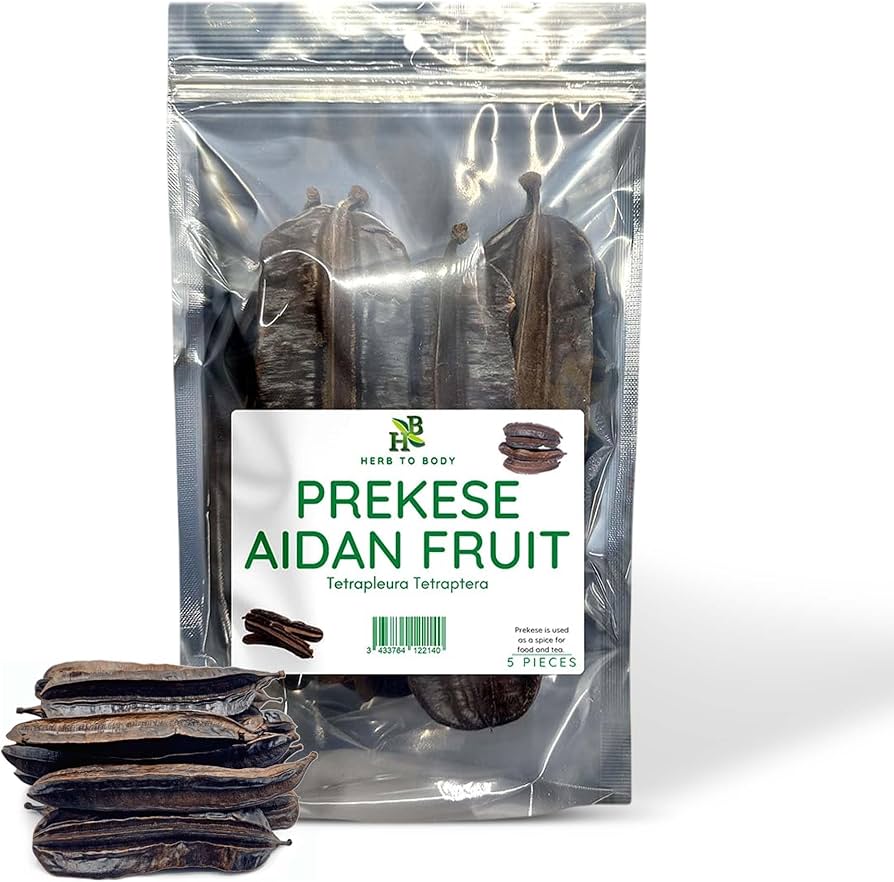Introduction
Aidan fruit — sometimes called prekese in Ghana, aridan in Nigeria, among other local names — comes from the tree species Tetrapleura tetraptera, native to West tropical Africa. (abs-biotrade.info)
This fruit is not widely known in many parts of the world yet, but within West African traditional medicine and cuisine it holds a significant place. The curved pod-like fruit has wing-like ridges, and inside there is aromatic pulp and seeds. (Medium)
In this article, we’ll explore what nutrients it contains, what health benefits are supported by scientific and traditional evidence, how it’s used, and important precautions to keep in mind.
Nutritional and phytochemical profile

Here are key aspects of what Aidan fruit offers:
- A proximate analysis found for the fruit: moisture ~5.06-8.22 %, protein ~5.61-6.69 %, carbohydrate ~58.48-63.86 %, fat ~11.19-24.71 %, fibre ~3.14-4.11 %. (PMC)
- It contains minerals and vitamins: for example, it has been reported to contain potassium, calcium, magnesium, zinc, iron, and vitamins such as C and others. (Medium)
- Phytochemicals: The fruit (and tree) contain flavonoids, phenolic compounds, tannins, saponins, alkaloids, terpenoids and others. These are the kinds of compounds associated with antioxidant, anti-inflammatory, antimicrobial and other biologic activities. (PMC)
Because of this combination of nutrients and phytochemicals, the fruit is regarded as a “functional food” in some research — meaning it may do more than just provide calories and basic nutrients. (PMC)
Health benefits
Here are some of the main health benefits attributed to Aidan fruit, with notes on the strength of evidence.
1. Antioxidant & anti-inflammatory effects
The presence of flavonoids, phenolics and other bioactive molecules means the fruit exerts antioxidant activity — i.e., it helps neutralize free radicals, reduce oxidative stress, and thus may help protect cells from damage. (PMC)
Its anti-inflammatory properties are supported by studies of extracts reducing markers of inflammation in animal models. (PMC)
Why that matters: Oxidative stress and chronic low-grade inflammation are implicated in many long-term diseases (cardiovascular disease, some cancers, metabolic disorders). So foods with antioxidant/anti-inflammatory potential are of interest.
2. Blood sugar regulation & diabetes support
Some animal studies show that Tetrapleura tetraptera fruit (or extracts) can improve glycaemic control (lower blood glucose) in diabetic animal models. (PMC)
This suggests the fruit may help support healthy metabolism of glucose.
Caveat: Most of the strong evidence is preclinical (animals, lab studies). Human clinical trials are limited, so one should not consider this a proven “diabetes cure”.
3. Cholesterol / cardiovascular-related effects
Because the fruit contains saponins and other compounds that may bind bile acids and influence lipid metabolism, research suggests it could help lower blood cholesterol levels. (PMC)
Additionally, its antioxidant and anti-inflammatory actions may further benefit cardiovascular health indirectly.
4. Digestive health & weight management
- The fibre content (as well as other compounds) may support digestion, promote a sense of fullness, and help regulate bowel movements. (Niyis African Supermarket)
- Traditional uses include “cleansing of the digestive system” and as part of weight-loss regimes. (abs-biotrade.info)
5. Antimicrobial / antiparasitic properties
Some studies have found that extracts from the fruit (and other tree parts) inhibit bacteria, fungi, malaria parasites (Plasmodium), and helminths. (PMC)
This does not mean one should rely solely on the fruit for treating infections, but it shows potential for further research.
6. Other traditional uses
In traditional West African medicine, Aidan fruit has been used for a wide variety of conditions: childbirth support, easing labour pains, asthma, leprosy, rheumatism, hypertension, and more. (abs-biotrade.info)
Some of these uses are less well substantiated by modern scientific trials — they come from ethnobotanical reports and oral tradition.
Culinary & traditional uses
- The fruit is used as a spice or flavour enhancer in West African cuisines: soups, stews, palm nut dishes, etc. Its pulp is aromatic and flavourful. (Medium)
- It is also used to make drinks: e.g., a tea or infusion from the pods. (Pinterest)
- Use as part of traditional medicine: pods may be ground, boiled, or included in herbal preparations.
How to use it & suggestions
- If you find the whole pod: it may need preparation (crushing the pod, removing inedible parts, boiling, soaking) before consumption.
- The easiest way: make a tea by boiling pieces of the dried pod in water, allow to steep, then drink. (Medium)
- In cooking: add crushed or powdered pod to soups, stews, sauces for flavour and aroma.
- As part of a balanced diet: using it as one component among many healthy foods rather than relying on it alone.
Precautions & things to be aware of
- Although promising, many of the health claims are based on preclinical or animal studies; human clinical evidence is limited.
- Safe dosage, long-term effects and potential interactions with medications are not well established in the scientific literature.
- If pregnant, breastfeeding, or with underlying health conditions (such as diabetes, high-blood pressure, etc.), one should consult a healthcare provider before using it for medicinal purposes.
- As with any new food/herb, there is potential for allergies or adverse reactions.
- Traditional uses (e.g., to assist labour) should not replace professional medical care where needed.
Conclusion
Aidan fruit (Tetrapleura tetraptera) is a fascinating fruit-pod from West Africa, rich in nutrients and phytochemicals, and long used in traditional medicine and cuisine. The scientific evidence is increasingly showing its potential antioxidant, anti-inflammatory, metabolic, and antimicrobial benefits. That said, more rigorous human studies are needed before we can fully validate many of the claims.
If you enjoy exploring new foods, and you have access to Aidan fruit (or its powdered or infused form), it may be a great addition to your diet — especially as a flavourful spice or herbal infusion. But remember: it should complement a healthy lifestyle, not be the sole “magic” component.


